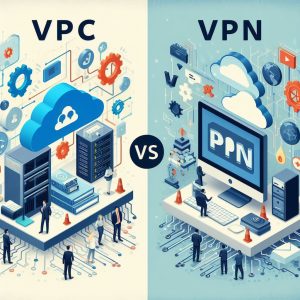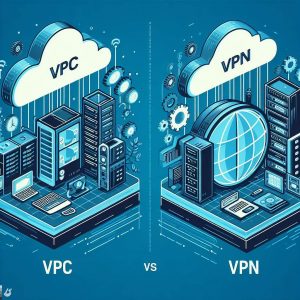Introduction
As cloud computing adoption accelerates, understanding the difference between a Virtual Private Cloud (VPC) and a Virtual Private Network (VPN) is critical for organizations to build optimal infrastructure. While VPC and VPN share some functionality as networking solutions for business agility, security and cost management, their capabilities differ significantly.
This article will clearly differentiate VPCs and VPNs, explore how they complement each other, compare use cases and costs, while assessing the security implications of each. By the end, you will have clarity regarding when to deploy VPCs versus VPNs and how they work in tandem for diverse networking needs.
VPC (Virtual Private Cloud)
A Virtual Private Cloud refers to an isolated private cloud computing environment provisioned within a public cloud provider’s infrastructure. VPC gives organizations complete control over their virtual networking environment minus the physical data center infrastructure costs.
Amazon Web Services pioneered the VPC concept, which is now offered by all major public cloud platforms including Microsoft Azure, Google Cloud and IBM Cloud. VPCs allow enterprises to leverage the scalability and agility of public cloud while maintaining security and isolation.
The core benefit of VPC is providing organizations the ability to define and control a virtual network in the public cloud completely isolated from other customers. This includes IP address ranges, subnets, route tables, network gateways and security settings. Essentially, VPC gives the same capabilities over the network as operating traditional private infrastructure.
VPCs consist of isolated sections of pure virtual networks inside public cloud data centers mapped to your account. You can create multiple VPCs within regions and span them across availability zones with full control over IP addressing and routing logic. VPC leverages VLAN technology allowing you to design isolated network segments similar to on-premise infrastructure.
A properly configured VPC minimizes security risks, enables complex network topologies and provides scalability and efficiency not possible with physical hardware constraints. Workload hosting, disaster recovery, application migration and development/testing are all enhanced using VPCs due to flexibility and security in the public cloud.
While traditional private clouds on company premises require significant capital expenditure on hardware and management costs, VPC provides flexibility and security of a private cloud at minimal incremental costs based on pay-as-you-go public cloud billing models.

VPN (Virtual Private Network)
A Virtual Private Network (VPN) refers to an encrypted private connection over the public internet between devices, networks or cloud environments isolated from other traffic. VPNs enable secure communication channels between machines, users and sites by establishing virtual point-to-point connections routed through public internet infrastructure.
VPNs provide Layer 3 network privacy through protocols such as IPSec and SSL/TLS designed to tunnel traffic to remote networks or users securely via authentication, encryption and traffic encapsulation functions. Remote users connecting to enterprise networks leverage VPN access for security and administrators use VPN gateways to seamlessly link infrastructure across the internet similar to traditional Wide Area Networks (WAN).
The core functions of VPN technology include encryption, tunneling, access control, data integrity checks and user authentication to facilitate private connections. VPN allows organizations to leverage the global reach, flexibility and cost efficiencies of the public internet for connectivity purposes without compromising security or manageability.
Site-to-site VPN allows offices in multiple fixed locations to connect through dedicated encrypted VPN tunnels instead of relying solely on dedicated MPLS links. Remote access VPN allows mobile users, work-from-home employees and external partners secure access privileges into company resources. Overall VPN technology enables significant cost savings and networking flexibility while still providing security and scalability across private networks.
VPC vs VPN
Now that we have outlined VPC and VPN individually, it is easier to draw distinctions between their respective purpose and capabilities. While both are critical networking technologies, they serve wholly different primary functions.
A VPC is a customizable, isolated virtual networking environment inside the public cloud. VPN focuses on creating encrypted tunnels through the public internet to connect users, sites and networks securely. While VPC offers private space for cloud workloads and networks, VPN technology enables protected transit across the public internet.
However, this is not an either/or scenario. VPC and VPN work together to enable flexible and secure cloud architecture. Through VPN gateways attached to VPC subnets, resources hosted in the virtual private cloud maintain encrypted connections across the internet to end users and third-party infrastructure. Meanwhile, VPC environments host VPN endpoints to enable aggregation with remote data centers, branches and mobile users.
Therefore, while their core functions differ, VPC and VPN unify to provide the full spectrum of cloud networking and security for modern infrastructure combining legacy environments, public cloud platforms and mobile access under one architecture.

Joint Use Cases
Given their symbiotic relationship, some of the most common use cases that leverage both VPC and VPN jointly include:
Secure Public Cloud Access: VPC subnets host VPN gateways to allow remote user access securely into public cloud environments via mobile VPN clients and lightweight directory access protocol (LDAP) for access controls.
Workload Migration: Leverage site-to-site VPNs to gradually migrate legacy workloads from private data centers into the public cloud VPC environment in a phased, secure manner.
Disaster Recovery Designs: Sync and replicate data between VPC availability zones and on-premise data centers via low latency site-to-site VPNs for comprehensive disaster resilience.
As cloud and legacy infrastructure unify under common architecture patterns, the junction of VPC and VPN will only expand allowing organizations to reap the benefits of public cloud without compromising security or flexibility.
Cost Comparison
From a cost perspective, VPCs and VPNs have distinct pricing models. VPC charges include network traffic flowing through virtual network components, public IP addresses allocated, route tables maintained per VPC, network access control lists and hourly instance usage fees. These costs depend on the specific cloud provider’s virtual infrastructure utilization pricing.
Meanwhile, VPN pricing varies based on gateway or client access fees, data processing costs per GB trafficked and number of tunnels maintained. Additional factors are encryption overhead processing and network bandwidth utilization. Therefore costs depend on user and access parameters.
Blended VPC and VPN cloud architecture can provide very compelling TCO value by leveraging the flexibility and scalability of the public cloud for peak capacity expansion/contraction compared to fixed on-premise infrastructure costs. Traffic flow optimization and secure access scenarios further reduce expenses.

Security Implications
Both VPC and VPN provide heightened security, isolation and access controls relative to traditional network infrastructure. However it is worth noting some core security differentiators:
VPC Security
- Isolated virtual network segments
- Stateful firewalls, DDoS protection
- Granular access control policies
- Hypervisor segregation from host
VPN Security
- Site-to-site encrypted tunnels
- Multi-factor authentication
- Encryption over public infrastructure
- LDAP, AD integration
Ultimately utilizing VPC and VPN in tandem provides a defense-in-depth approach across networking architecture. VPC security controls protect east-west traffic flows and intranet integrity while VPN gateways encrypt external access vectors from endpoint to endpoint.
As you evaluate cloud migration, continuity planning and mobile access requirements, incorporating this blended model delivers robust, mature and layered cybersecurity coverage exceeding legacy frameworks.
Conclusion
In closing, as digital transformation initiatives embrace cloud and mobility emphasis, VPC and VPN emerge as cornerstones of future-ready enterprise architecture by blending the isolation and flexibility of virtual networking with broadly accessible encrypted connectivity.
VPC offers secured, privatized workload hosting to harness cloud agility and efficiency gains. Meanwhile VPN provides ubiquitous protected access to unify hybrid infrastructure. Using both together, companies can reorient IT around accessibility, security and responsiveness.
Hopefully this breakdown has provided clarity regarding how VPC and VPN interoperate while serving unique purposes. As infrastructure complexity grows exponentially, leveraging these technologies in tandem will maximize capability for organizations while minimizing costs and risks.